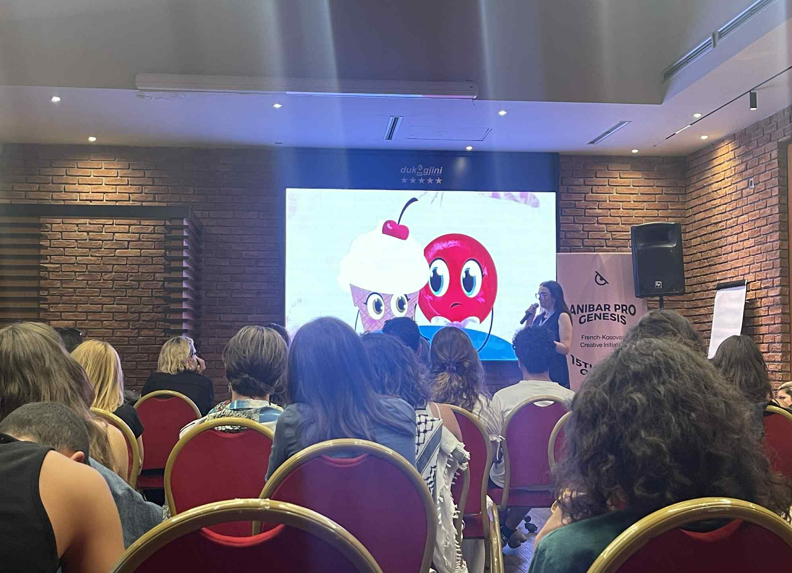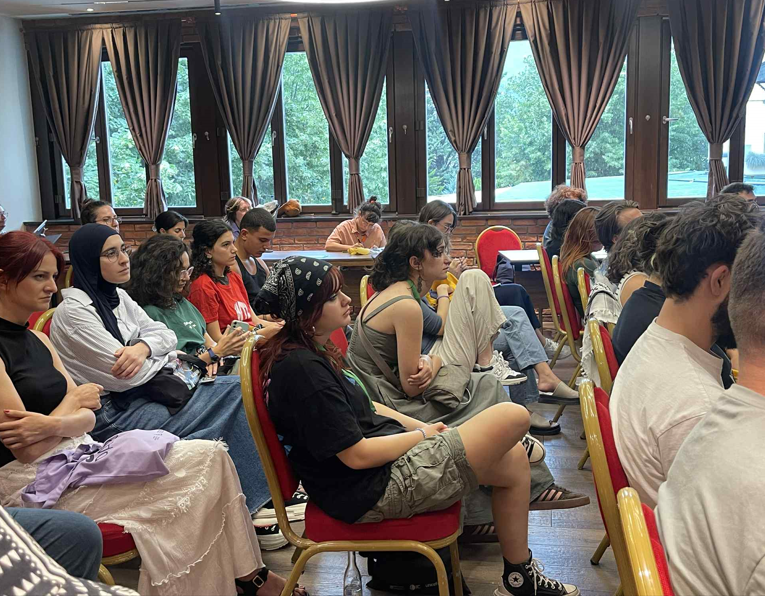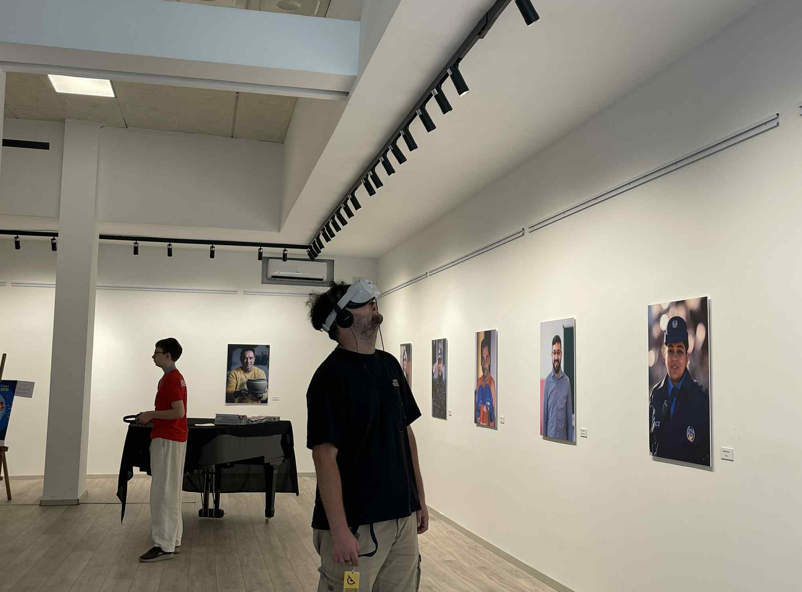Embracing confusion and provocation, the 16th edition of Kosovo’s Anibar International Animation Festival challenges the audience with the theme “WTF?! is not a theme”, by using animation to show that the most meaningful stories often start with a simple, unresolved “what the future/f…?!”
On July 17, at the Creative Centre “Dukagjini” Albana, an animator from Prishtina stepped out onto the stage laughing nervously as she prepared to present the details of her animation pitch for the first time before the jury, mentors, and the public.
While introducing her concept “Stick with me,” she used the image of pests stuck to a lollipop to send a message about friendships that shouldn’t be clung to.
“As a child, I wasn’t very good at making friends, and I often used to stick to people,” she shared. “As I grew older, I began to reflect on that.”
She explained that a sticky lollipop covered in bugs, ones you can’t easily get rid of, perfectly illustrated the essence of her idea.

Presentation of Pitch Story Animations at the Dukagjini Creative Center. Photo: BIRN/Ardita Zeqiri
Just like Albana, other young creators also brought emotion to the stage, hoping their presentations would gain the attention they deserve and eventually develop into something more lasting than just an illustration.
Their personal and often surreal ideas explored topics of freedom, fear, dreams, and post-reality existence, fully embracing this year’s theme of Kosovo’s Anibar International Animation Festival.
Running from July 14–20, 2025, the Peja/Pec based animation festival has transformed the city into a colorful, experimental space where animation isn’t just entertainment, it is healing, rebellion, and absurdity.
The heavy rain that swept through the city on Thursday didn’t stop the organisers from continuing with the programme, though there were some delays, especially for the open-air cinema.
“Thank you, rain,” said the coordinator of the Pitch Stories project Donarta Fetahu with a hint of irony as she thanked the young participants for their pitches and the attendees for their support and the attention they gave to the young talents presenting their animation concepts.
This edition’s theme is “WTF?!”, which can mean many things: What’s the future? What the f*ck? We’re not okay, and certainly: The world is not okay.
“Anibar has embraced all these meanings and put them into an animated chaos. With its mix of indoor and outdoor cinema, and youthful energy, the festival invites visitors to ‘come with questions, come with feelings’—promising the unexpected,”the festival highlights.
Conversations that matter

Participants in Anibar Festival Activities in Peja.
Photo: BIRN/Ardita Zeqiri
Young festival enthusiasts gathered in the hallway of the Jusuf Gërvalla cinema, which was transformed into a recreational space, eagerly asking questions and listening to filmmakers share their experiences.
Post-screening conversations with filmmakers also offer a look behind the curtain. Audiences get to hear firsthand the filmmakers doubts and struggles.
“These aren’t just films,” one director explained, “they’re fragments of ourselves.”
Anibar’s programme extends beyond screenings. This year, panel discussions explore challenges that many creatives in the Balkans face during their work: breaking into international markets, telling stories ethically, and protecting their own mental health during times of crisis.
And even international guests are charmed.
Dimitri De Keukelaere, a teacher from Belgium attending Anibar for the first time, felt the charm of this session. In a statement to Prishtina Insight he said: “It’s a relaxed, wonderful, and very human festival.”
Emotional honesty is portrayed in many of the films in the international competition, screened at the Lakeside cinema and Kino Çarshia.
In this year’s edition there is a special programme on Palestine. A selection of animated films exploring life under occupation, childhood in conflict, and memories carried through generations.
These films are intimate and humane, told through the eyes of children, mothers, or survivors. They remind audiences that animation, though often associated with fantasy, can be a powerful tool for political truth and historical acknowledgement.

Children’s program at the Dukagjin Creative Center. Photo: BIRN/Ardita Zeqiri
Over the past 12 months, Kosovo students have been learning animation techniques and studying the French language as part of GENESIS, a new initiative launched by Anibar Pro last year in partnership with French institutions.
Donarta Fetahu, Anibar’s project coordinator, explained: “this is the first time we’re launching GENESIS. It’s been a collaborative experience, with Kosovo and French students learning together. Today’s pitching forum is the result of a year of preparation, mentorship, and imagination.”
The presence of international mentors and producers provides these animators with feedback, but also hope that their work can come to life and travel beyond Kosovo’s borders.
Reality is virtual too

Participants in the Virtual Reality Session at the Anibar Festival. Photo: BIRN/Ardita Zeqiri
The Art Gallery in Peja, typically used for various exhibitions, was transformed by Anibar into a creative hub for young people and a space for Virtual Reality, VR, sessions.
According to VR coordinator Lis Arifaj, five interactive and non-interactive VR films are on display, each under 30 minutes and for free.
“Some of the films require you to move, look around, or make choices, others simply let you observe. But, either way, it’s a new kind of storytelling,” he said.
This turned out to be one of the most popular attractions at the festival, with visitors requesting to watch more than one VR film, since it was a completely new experience for many of them.
The Young Audience Programme was held in the same centre, where children were shown animations selected for them, some of which were also in the competition programs at the festival.
Peja resident and youth activist Nora Draga is more than happy to see the growing impact of this festival taking place in her city.
“As someone who works with young people, I’m thrilled to see how Anibar brings so much energy, creativity, and people from around the world to our city. Peja has so much to offer—culturally and naturally. This festival is like a breath of fresh air for both the youth and the whole community.”

Musical Performance at Karagaç Park. Photo Courtesy: Anibar Festival
Meanwhile, the evening program blends animation and live music. Festivities and performances by artists from Kosovo and the region continue at Karagac park.
Born from the vision of a group of young activists in Peja in 2010, the festival has grown into a space where art, politics, and youth culture intersect, with each edition exploring different themes.
Over the span of one week, four cinemas—two indoors and two under the open sky, including a lakeside venue—host screenings of over 300 films across 10 categories, ranging from experimental shorts and animated documentaries to student films and virtual reality experiences.





